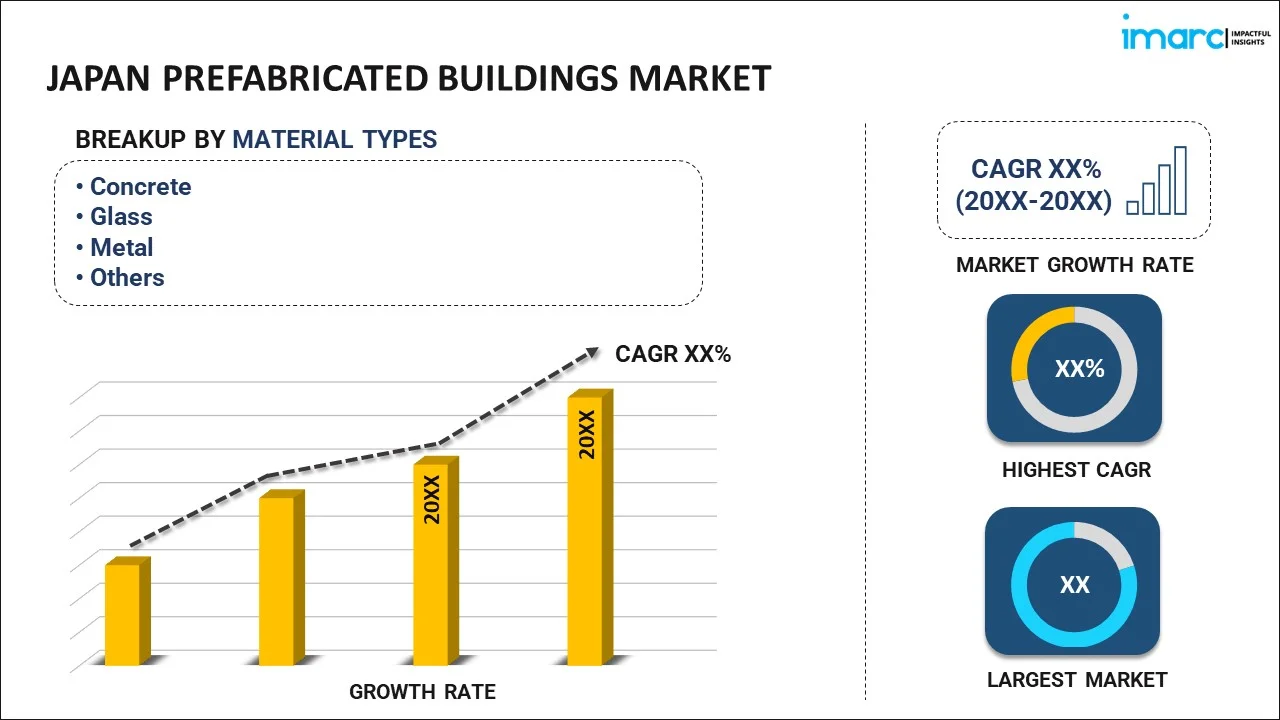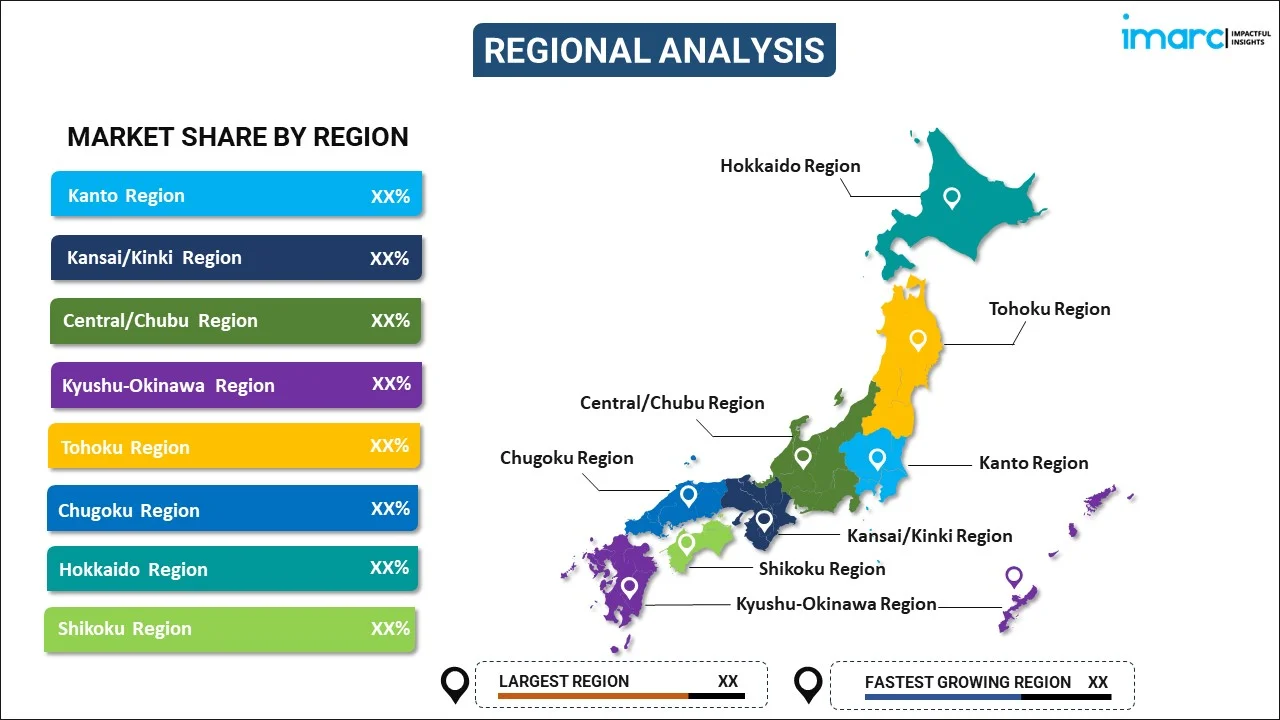
Japan Prefabricated Buildings Market Report by Material Type (Concrete, Glass, Metal, Timber, and Others), Application (Residential, Commercial, and Others), and Region 2025-2033
Market Overview:
Japan prefabricated buildings market size reached USD 16.4 Billion in 2024. Looking forward, IMARC Group expects the market to reach USD 29.4 Billion by 2033, exhibiting a growth rate (CAGR) of 6.18% during 2025-2033. The ongoing advances in construction technology, such as Building Information Modeling (BIM) and Computer-Aided Design (CAD), that have made it easier to design and manufacture prefabricated components with precision is primarily driving the market.
|
Report Attribute
|
Key Statistics
|
|---|---|
|
Base Year
|
2024 |
|
Forecast Years
|
2025-2033
|
|
Historical Years
|
2019-2024
|
| Market Size in 2024 | USD 16.4 Billion |
| Market Forecast in 2033 | USD 29.4 Billion |
| Market Growth Rate (2025-2033) | 6.18% |
Prefabricated buildings, also known as prefab structures, are construction units manufactured in a controlled environment away from the actual building site. These components, which can include walls, floors, roofs, and other architectural elements, are produced using various materials such as steel, concrete, wood, or even advanced composites. Once completed, they are transported to the construction site and assembled. Prefabrication offers numerous advantages. It significantly reduces construction time, as components are ready-made and can be quickly assembled. This not only saves labor costs but also minimizes disruptions in the surrounding area. Prefabricated buildings are often more cost-effective due to standardized production processes and reduced material waste. Moreover, prefabrication allows for greater precision in construction, resulting in higher quality and durability. These buildings can range from simple modular structures to complex architectural designs, making them versatile for various applications, including residential, commercial, and industrial purposes.
Japan Prefabricated Buildings Market Trends:
The prefabricated buildings market in Japan is experiencing robust growth, primarily driven by several key factors that are reshaping the construction industry. One of the prominent drivers is the growing regional population and urbanization trends. As more individuals migrate to cities in search of better opportunities, the demand for affordable and quick-to-build housing solutions has surged. Prefabricated buildings offer a faster construction process, reducing labor and time costs while addressing the pressing need for housing in urban areas. Another crucial driver is sustainability and environmental consciousness. Prefabricated buildings often incorporate eco-friendly materials and construction methods, aligning with the increasing emphasis on reducing the carbon footprint in the construction sector. Moreover, governments and regulatory bodies in Japan are promoting green building practices, further incentivizing the adoption of prefabricated structures. In addition to this, technological advancements in design, manufacturing, and assembly processes, such as automation, 3D printing, and Building Information Modeling (BIM), which help to improve precision and efficiency, are expected to drive the market in Japan.
Japan Prefabricated Buildings Market Segmentation:
IMARC Group provides an analysis of the key trends in each segment of the market, along with forecasts at the country level for 2025-2033. Our report has categorized the market based on material type and application.
Material Type Insights:

- Concrete
- Glass
- Metal
- Timber
- Others
The report has provided a detailed breakup and analysis of the market based on the material type. This includes concrete, glass, metal, timber, and others.
Application Insights:
- Residential
- Commercial
- Others
A detailed breakup and analysis of the market based on the application have also been provided in the report. This includes residential, commercial, and others.
Regional Insights:

- Kanto Region
- Kansai/Kinki Region
- Central/ Chubu Region
- Kyushu-Okinawa Region
- Tohoku Region
- Chugoku Region
- Hokkaido Region
- Shikoku Region
The report has also provided a comprehensive analysis of all the major regional markets, which include Kanto Region, Kansai/Kinki Region, Central/ Chubu Region, Kyushu-Okinawa Region, Tohoku Region, Chugoku Region, Hokkaido Region, and Shikoku Region.
Competitive Landscape:
The market research report has also provided a comprehensive analysis of the competitive landscape in the market. Competitive analysis such as market structure, key player positioning, top winning strategies, competitive dashboard, and company evaluation quadrant has been covered in the report. Also, detailed profiles of all major companies have been provided.
Japan Prefabricated Buildings Market Report Coverage:
| Report Features | Details |
|---|---|
| Base Year of the Analysis | 2024 |
| Historical Period | 2019-2024 |
| Forecast Period | 2025-2033 |
| Units | Billion USD |
| Scope of the Report | Exploration of Historical and Forecast Trends, Industry Catalysts and Challenges, Segment-Wise Historical and Predictive Market Assessment:
|
| Material Types Covered | Concrete, Glass, Metal, Timber, Others |
| Applications Covered | Residential, Commercial, Others |
| Regions Covered | Kanto Region, Kansai/Kinki Region, Central/ Chubu Region, Kyushu-Okinawa Region, Tohoku Region, Chugoku Region, Hokkaido Region, Shikoku Region |
| Customization Scope | 10% Free Customization |
| Post-Sale Analyst Support | 10-12 Weeks |
| Delivery Format | PDF and Excel through Email (We can also provide the editable version of the report in PPT/Word format on special request) |
Key Questions Answered in This Report:
- How has the Japan prefabricated buildings market performed so far and how will it perform in the coming years?
- What has been the impact of COVID-19 on the Japan prefabricated buildings market?
- What is the breakup of the Japan prefabricated buildings market on the basis of material type?
- What is the breakup of the Japan prefabricated buildings market on the basis of application?
- What are the various stages in the value chain of the Japan prefabricated buildings market?
- What are the key driving factors and challenges in the Japan prefabricated buildings?
- What is the structure of the Japan prefabricated buildings market and who are the key players?
- What is the degree of competition in the Japan prefabricated buildings market?
Key Benefits for Stakeholders:
- IMARC’s industry report offers a comprehensive quantitative analysis of various market segments, historical and current market trends, market forecasts, and dynamics of the Japan prefabricated buildings market from 2019-2033.
- The research report provides the latest information on the market drivers, challenges, and opportunities in the Japan prefabricated buildings market.
- Porter's five forces analysis assist stakeholders in assessing the impact of new entrants, competitive rivalry, supplier power, buyer power, and the threat of substitution. It helps stakeholders to analyze the level of competition within the Japan prefabricated buildings industry and its attractiveness.
- Competitive landscape allows stakeholders to understand their competitive environment and provides an insight into the current positions of key players in the market.
Need more help?
- Speak to our experienced analysts for insights on the current market scenarios.
- Include additional segments and countries to customize the report as per your requirement.
- Gain an unparalleled competitive advantage in your domain by understanding how to utilize the report and positively impacting your operations and revenue.
- For further assistance, please connect with our analysts.
 Inquire Before Buying
Inquire Before Buying
 Speak to an Analyst
Speak to an Analyst
 Request Brochure
Request Brochure
 Request Customization
Request Customization




.webp)




.webp)












